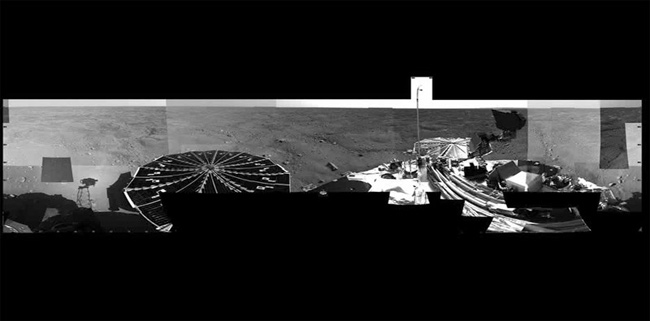Phoenix Lander Stretches Arm, Surveys Martian Arctic

TUCSON, Ariz. - NASA?sPhoenix Mars Lander has flexed its robotic arm for the first time and takena fish-eye panorama of its surroundings, mission scientists said Thursday.
?We have now achieveda major milestone for this mission,? said Phoenix project manager BarryGoldstein of NASA?s Jet Propulsion Laboratory (JPL) via a video link in a mission briefing held hereat the University of Arizona.
Phoenix beamed backimages that confirmed it had successfully unstowed its scoop-tipped arm, as it steadilysettles in at its northern polar home since its successfulSunday landing.
?I?m ecstatic to let youknow that [the robotic arm deployment] was successful,? said Matt Robinson, theRobotic Arm Flight Software Lead at JPL. ?It is raring to go. It?s busted loosenow and we?re ready to go.?
Phoenix also sent backa completed black-and-white panorama mosaic of its landing site, showing thedeployed solar arrays, robotic arm, meteorological mast and the flat terrainstretching out toward the horizon. The $422 million spacecraft is designedto dig down into the Martian arctic soils to the layers of water icethought to lie beneath the surface.
?We have a veryhummocky terrain,? said Phoenix principal investigator Peter Smith of theUniversity of Arizona, describing the polygonal-shaped bumps that cover thearctic landscape and which are separated by trenches in the soil. The shapesare believed to be formed by the expansion and contraction of the water iceunderneath.
The images also show ascattering of ?flat, table-like rocks,? as Smith described them.
Get the Space.com Newsletter
Breaking space news, the latest updates on rocket launches, skywatching events and more!
The Phoenix scienceteam has begun naming the rocks they find to keep track of them, using a fairytale and folklore theme (so that the science team can have a little fun, Smithsaid). The rocks that have been named so far include ?Humpty Dumpty,? the?King?s Men,? and ?Alice? (in reference to Lewis Carroll?s ?Alice inWonderland?).
The science team plansto use the robotic arm to move some of the rocks, which are only a few inchesacross, to see what?s underneath them. They will also investigate the origin ofthe rocks.
?The rocks don?t comewith labels, it?s a little hard to tell where they came from,? Smith said.
But first, missioncontrollers plan to test out the robotic arm?s joints in higher and lowertemperatures on the red planet, ?and that?s because the robotic arm is going tobe required to move at a range of temperatures,? Robinson explained. Weatherreports from the surface so far show a high temperature at the landing siteof -22 degrees Fahrenheit (-30 degrees Celsius) to a low of -112 F (-80 C).
Controllers will alsoposition the arm so that the camera attached to its scoop can snap a picture ofthe surface under the lander, to make sure no rocks are there.
Scientists havedivided the terrain into two parts: a ?national park? area that missionscientists will leave untouched until they have better characterized theenvironment, and an area they can use to test out the robotic arms diggingcapabilities.
?It?s more of aSuperfund site over there, so we?re allowed to mess that part up a bit,? Smithsaid.
Digging likely won?tstart until the middle of next week, mission scientists said.
NASA's next Phoenix mission briefing will be broadcast liveon NASA TV at 2:00 p.m. EDT (1600 GMT) on Friday, May 30. Clickhere for SPACE.com's Phoenix mission coverage anda linkto NASA TV.
- Video: Sounds From Phoenix Mars Lander's Descent
- New Images: Phoenix on Mars!
- Video: The Nail-Biting Landing of Phoenix on Mars
Join our Space Forums to keep talking space on the latest missions, night sky and more! And if you have a news tip, correction or comment, let us know at: community@space.com.

Andrea Thompson is an associate editor at Scientific American, where she covers sustainability, energy and the environment. Prior to that, she was a senior writer covering climate science at Climate Central and a reporter and editor at Live Science, where she primarily covered Earth science and the environment. She holds a graduate degree in science health and environmental reporting from New York University, as well as a bachelor of science and and masters of science in atmospheric chemistry from the Georgia Institute of Technology.









